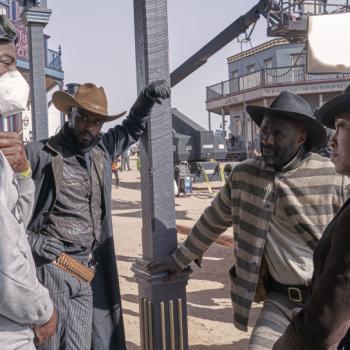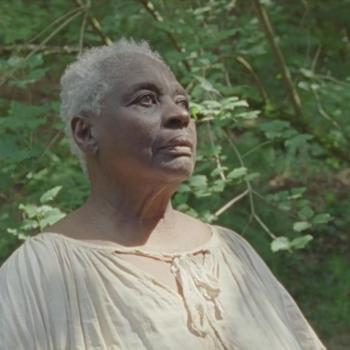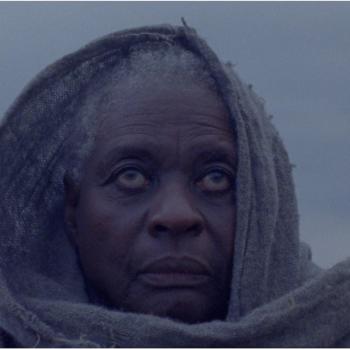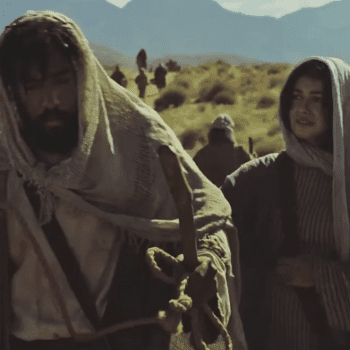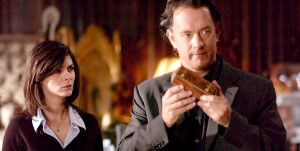 The makers of The Da Vinci Code have been saying for some time now that their film is not supposed to be taken all that seriously. It’s not history, and it’s not theology, director Ron Howard has said; instead, it’s just a rollicking good bit of entertainment. And leading man Tom Hanks has said it’s loaded “with all sorts of hooey and fun kind of scavenger-hunt-type nonsense,” calling the story “a lot of fun.”
The makers of The Da Vinci Code have been saying for some time now that their film is not supposed to be taken all that seriously. It’s not history, and it’s not theology, director Ron Howard has said; instead, it’s just a rollicking good bit of entertainment. And leading man Tom Hanks has said it’s loaded “with all sorts of hooey and fun kind of scavenger-hunt-type nonsense,” calling the story “a lot of fun.”
If only they had taken their own advice. Dan Brown’s novel may be the product of extremely sloppy historical study, but even many of the book’s critics have admitted that it is a “page-turner,” an exciting yarn that carries the reader off on a semi-clever, fast-paced ride. The film, on the other hand, is a dull and plodding bore, and it takes itself far, far too seriously.
For those who have not yet read the book or any summaries thereof, the story begins with an albino monk named Silas (Paul Bettany) shooting Jacques Sauniere (Jean-Pierre Marielle), the curator of the Louvre museum in Paris. In his dying moments, Sauniere strips off his clothes, cuts a symbol into his own flesh, and scrawls some cryptic messages in invisible ink in various places around the museum. Police chief Bezu Fache (Jean Reno) summons Robert Langdon (Tom Hanks), an expert on symbols, to the Louvre and comes to believe that Langdon might be the killer — but while he is plotting to arrest Langdon, Sauniere’s granddaughter Sophie Neveu (Audrey Tautou), herself a police officer, helps Langdon to escape. Langdon and Sophie then run all over France and, eventually, England, dodging the police while solving the coded puzzles that Sauniere left behind — puzzles which lead to a secret society that claims everything Christians believe is a lie.
The thing to remember about Dan Brown’s novels, and now the adaptations thereof, is that they are fundamentally silly. Few books have made me laugh out loud as heartily as Angels & Demons, the first novel to feature the character of Robert Langdon, in which Langdon makes the ludicrous claim that Christians “borrowed” the practice of Holy Communion from the Aztecs — a North American culture that didn’t encounter Christianity until nearly 1,500 years after the life of Jesus. And I have always gotten a giggle from the Da Vinci Code trailer, in which Langdon’s eccentric friend Sir Leigh Teabing (Ian McKellen) gravely intones that he knows a secret which, if revealed, would “devastate the very foundations of mankind.” Ah, so grandiose!
In the movie, however, Teabing says that the secret he knows would “devastate the very foundations of Christianity,” a much more specific, and offensive, sort of claim. And the movie, written by Akiva Goldsman (A Beautiful Mind), seems to go out of its way to give the story even more historical credibility than the novel does. One of the amusing things about the book is how Brown slaps together as many cultural reference points as possible — from high-brow Renaissance art to popular Disney cartoons — in a sort of post-modern pastiche to create the impression that the conspiracies and secret societies he describes are everywhere around us. But in the film, everything is played with a very straight face, the pop-culture allusions are eliminated altogether (as are some of the book’s loopier claims), and our focus stays on the classic and medieval paintings, sculptures and architecture.
In addition, Robert Langdon has been made into more of a skeptic, so that when he talks about the Priory of Sion (the secret society that is supposedly protecting the descendants of Jesus and Mary Magdalene), he refers to them, at first, as a “myth.” He even says the group was exposed as a “hoax” in 1967 — a claim which prompts Teabing to say, “That’s what they want you to believe.” Also, in the book, Teabing says that Mary Magdalene was labeled a “prostitute” by “the early church” as part of a “smear campaign,” and leaves it at that; but in the film, Langdon specifies A.D. 591 as the date when Mary Magdalene was formally identified as a prostitute. (That was the year when Pope Gregory gave a sermon claiming that Mary Magdalene, Mary of Bethany, and the “sinful woman” who washed Jesus’ feet were all the same woman.)
What’s more, Langdon and Teabing now play a sort of good-cop-bad-cop routine. The book flat-out states that “five million” (emphasis in the original) women were killed by the Catholic church over 300 years, and it states this in a passage that seems to be reflecting Langdon’s own thoughts as he thinks back on the history of the church. But in the film, Langdon says the number was 50,000, and then Teabing interjects that some would say the victims actually numbered in the “millions.” Also, when Teabing says that the emperor Constantine had to intervene in religious matters in the early 4th century because Christians were rioting against pagans in the streets (a claim that is brought to visual life in a brief, violent flashback), Langdon interjects and says that the pagans might have started the atrocities first — a claim that is never backed up by anything on the screen. And the film’s version of Langdon explicitly says that Constantine did not invent the divinity of Jesus — which is almost the exact opposite of what the book’s version of Langdon says.
The changes the film makes to Langdon have a subtle, even sinister, effect. The book tends to emphasize his superior knowledge, which could have the effect of distancing him from the average moviegoer. But the film casts Everyman actor Tom Hanks in the role, and then makes Langdon a moderate Everyman who initially finds Teabing’s claims too crazy. The thing is, as far as this story is concerned, Langdon comes to discover that Teabing, for all his anti-ecclesiastical kookiness, is actually right. In short, the film is the story of how Langdon comes to believe in Teabing’s theories; and because Langdon has been made more accessible, he takes the audience along with him on his journey to this new belief. And while all this is going on, the film’s explicitly Christian characters — Silas, Fache, and the manipulative Bishop Aringarosa (Alfred Molina), who takes his own cues from a mysterious unseen “Teacher” — are all portrayed as pathetic dupes, let down by their own beliefs.
In one of the final scenes, Langdon tries to spell out the film’s main theme. Referring to the nature of Jesus, Langdon asks, “Why does it have to be human or divine?” At this point, I half-expected Tom Hanks to go into Forrest Gump mode and say, “Maybe it’s both” — which would, of course, be the orthodox position (even if we might quibble with what the film says about the way Jesus expressed his humanity during his earthly ministry). But no, instead, Langdon’s next words are, “Maybe human is divine.” Which may be very soothing to the post-modern ear, but it just begs the questions: What is divinity? What is humanity?
Given this kind of dialogue, it’s impossible to take the filmmakers seriously when they say that their movie makes no historical or theological claims. Why did they feel the need to add details missing from Brown’s book, or to correct some of its errors, if the historical claims didn’t really matter? And would they have been just as pleased with a closing scene in which Langdon said Jesus is the divine Son of God who became man to show us how to become the fully human beings we were originally meant to be? Somehow, I doubt it.
And what of the entertainment, the rollicking good thrill ride that the filmmakers say they are trying to give us? Truth be told, whether it’s Silas popping out of nowhere with a weapon in his hand, or Langdon accidentally disarming an ally who turns out to be a gun-packing enemy, or Sophie driving a car backwards through busy traffic, these are among the movie’s weakest and most generic elements. The performances are all pretty grim, too; only McKellen, as Teabing, seems to be having any fun. And Howard’s direction emphasizes all the wrong things; the quasi-academic exposition, which is what has intrigued most fans of the book, is tossed off so rapidly in places that you almost miss it, whereas the camera dwells at some length on scenes of the albino monk’s self-flagellation, among other things. Hans Zimmer’s musical score is effective in places, at least, but it would have been even better if it didn’t sound like a carbon copy of the themes he wrote for Batman Begins.
Bottom line: If you want an entertaining yarn about the Knights Templar, historical secrets, and cryptic codes hidden in famous documents and artifacts, go rent National Treasure. Now there’s a movie that knows how to have fun with an absurd premise — and it doesn’t spread falsehoods about the Church that have already undermined the faith of many Christians. The best thing that can be said about The Da Vinci Code is that it is such a dud, it just might help to bring this phenomenon to an end. And the sooner, the better.
1.5 stars (out of 4)
–
Talk About It
Discussion starters
1. Can a movie like this can be “only entertainment”? How do you respond to its images of the Nicene Council, or of early Christians rioting in the streets? How do the movie’s visuals tilt your sympathies? Are you more inclined to believe one character than another?
2. A nun tells Silas, “Jesus had but one true message.” Does this movie say what that message is? If so, what is it? How does the nun’s statement square with the scene in which Langdon tells Sophie that what matters is what she believes? What does the movie suggest about the possibility of an exclusive truth claim, vs. the idea of many valid beliefs?
3. Do you think the bones of Mary Magdalene pose any threat to Christianity? What do you make of the churches which claim to have her relics? Would there be a way to say if those relics were the true ones? Does it matter? Why do you think no one in the film ever shows any interest in the bones of Jesus?
4. Sophie tells Silas, “Your God doesn’t forgive murderers. He burns them!” How would you answer this? Do you think Sophie believes in God? Do you think Silas can be forgiven for what he has done?
5. Can anything be “proved” historically? To what degree is history an act of faith? How do movies, including earlier Ron Howard or Tom Hanks movies like Saving Private Ryan or Apollo 13, shape our view of history? How do they shape our faith?
The Family Corner
For parents to consider
The Da Vinci Code is rated PG-13 for disturbing images, violence (including shootings, kickings, impalings, poisonings, and the breaking of necks), some nudity (of a monk’s naked behind, before he whips himself), thematic material (including the depiction of Mary Magdalene bearing the child of Jesus, Christians killing pagans in the streets in the days before Constantine legalized Christianity, the Crusaders conquering Jerusalem, and Teabing’s claim that Constantine “presided over” the creation of the Bible), brief drug references (when Teabing asks the police if they’ve discovered any cannabis) and sexual content (in a very brief flashback where the young Sophie witnesses her grandfather having sex as part of a secret religious ritual; but their bodies are covered by a blanket).
— A version of this review was first published at Christianity Today Movies.



